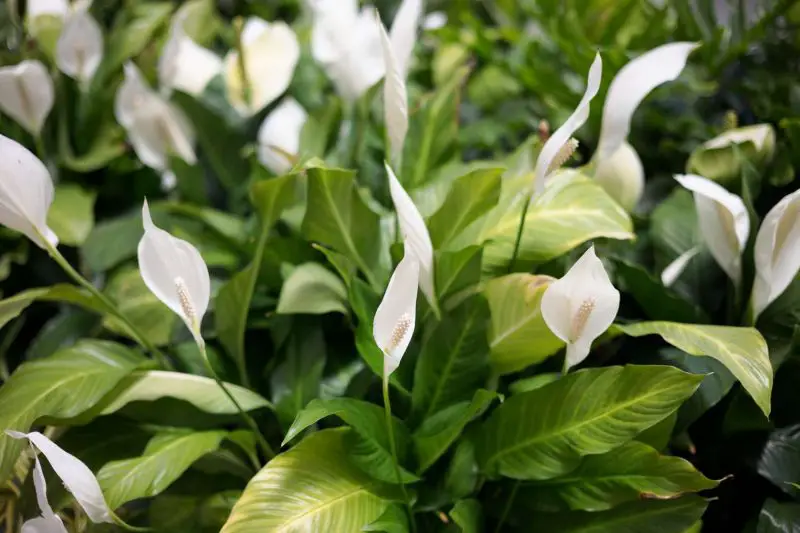Peace lilies are among the most cherished indoor plants due to their lush green foliage and elegant white spathes that resemble flowers. These tropical perennials are more than just beautiful—they are also known for their air-purifying abilities, making them a favorite among houseplant lovers and interior designers. Understanding how to care for a peace lily properly is the key to ensuring it stays healthy and vibrant throughout the year, regardless of changing seasons.
While peace lilies are relatively low-maintenance, they still require specific conditions to thrive. From light and watering needs to soil preferences and propagation, there are many factors that influence their growth. With the right care routine, your peace lily can flourish indoors, offering continuous beauty and freshness.
This comprehensive guide will walk you through everything you need to know to care for your peace lily and keep it thriving all year long. Whether you’re new to houseplants or an experienced indoor gardener, the following sections will provide valuable insights to help you master peace lily care.
Understanding the Nature of the Peace Lily

Peace lilies, known scientifically as Spathiphyllum, are native to the tropical rainforests of Central and South America. In their natural environment, they thrive on the forest floor, shaded by towering trees, where they receive diffused sunlight and constant moisture. This background explains their preference for low to moderate indirect light and high humidity when grown indoors.
Despite their name, peace lilies are not true lilies. They belong to the Araceae family, which includes other popular houseplants like philodendrons and anthuriums. Their signature white “flowers” are actually modified leaves called spathes that surround the central spadix, which contains the real flowers. These spathes often bloom throughout the year under the right conditions.
Understanding the peace lily’s natural habitat is crucial to replicating ideal growing conditions at home. The closer you can mimic its tropical environment, the more likely your plant will stay healthy and bloom consistently.
Choosing the Right Location for Your Peace Lily
Location is one of the most important factors in successful peace lily care. Because these plants evolved under the canopy of rainforests, they are adapted to thrive in low light conditions. However, they still need a moderate amount of indirect sunlight to grow well and produce blooms.
A spot near a north- or east-facing window is usually ideal. These windows provide the soft, indirect light peace lilies enjoy. If placed near a south- or west-facing window, it’s essential to shield the plant with a sheer curtain to prevent scorching from harsh afternoon sun. Direct light can cause leaf burn and reduce flowering.
Temperature and airflow are equally important. Peace lilies prefer temperatures between 65°F and 80°F, and they do not tolerate cold drafts or sudden temperature fluctuations. Avoid placing them near heaters, air conditioners, or open windows during winter, as this can stress the plant and cause yellowing leaves or wilting.
Watering Your Peace Lily the Right Way
Watering is often the trickiest part of peace lily care, as overwatering and underwatering can both lead to problems. These plants are sensitive to moisture levels and will often droop to signal distress, which can be confusing to beginners.
The goal is to keep the soil consistently moist but never soggy. Check the top inch of soil with your finger; if it feels dry, it’s time to water. Use room-temperature, filtered water when possible, as peace lilies are sensitive to chemicals like chlorine and fluoride often found in tap water. If filtered water isn’t available, allow tap water to sit overnight before use.
Water thoroughly until liquid drains from the bottom of the pot, ensuring the roots receive adequate moisture. Then, empty the saucer to prevent root rot. During the growing season, typically spring and summer, your peace lily may need watering more frequently. In fall and winter, reduce watering to match the plant’s slower growth rate.
Providing the Right Humidity and Air Circulation
Peace lilies flourish in environments with moderate to high humidity, mirroring the conditions of their tropical origins. Indoor air, especially in winter when heating systems are in use, tends to be dry and can negatively affect your plant’s health. Low humidity may lead to brown leaf tips and slowed growth.
To increase humidity, consider using a humidifier in the room where your peace lily is located. Alternatively, placing the pot on a tray filled with pebbles and water can help by allowing moisture to evaporate around the plant. Grouping plants together also creates a microclimate with improved humidity.
While peace lilies appreciate moisture, they also benefit from proper air circulation. Stagnant air can encourage mold, fungus, or pests. Keep your plant in a well-ventilated space but away from direct drafts. Occasional gentle air movement from a fan can improve plant health and reduce fungal issues.
Choosing the Ideal Potting Soil and Container
The type of soil you use has a significant impact on how well your peace lily grows. These plants require well-draining, nutrient-rich potting mixes to support healthy roots and foliage. A suitable blend might include peat moss or coco coir for moisture retention, combined with perlite or coarse sand to improve drainage.
Avoid heavy garden soils or potting mixes that retain too much water, as this increases the risk of root rot. Commercial houseplant mixes labeled for aroids or tropical plants often work well for peace lilies. You can also amend general potting soil with additional perlite for better airflow.
When selecting a container, ensure it has drainage holes to prevent excess water from sitting at the bottom. Terra cotta pots are a good choice because they are porous and help wick away moisture, preventing overwatering. Repotting your peace lily every 1 to 2 years can refresh the soil and provide space for growing roots.
Feeding Your Peace Lily Through the Seasons
Fertilizing your peace lily can enhance its growth and encourage more frequent blooming. While they are not heavy feeders, they do benefit from occasional nutrients, especially during the active growing months of spring and summer.
Use a balanced, water-soluble fertilizer diluted to half strength about once a month. Overfertilizing can lead to salt buildup in the soil and cause leaf tip burn, so it’s better to err on the side of caution. If your plant is healthy and blooming regularly, minimal feeding may be sufficient.
During the fall and winter months, peace lilies enter a semi-dormant state and require less nutrition. You can pause fertilizing during this time and resume in early spring when growth begins to pick up again. Always water the plant before applying fertilizer to avoid root burn.
Pruning and Cleaning for a Healthy Appearance
Pruning peace lilies helps keep them looking tidy and encourages new growth. Remove any yellowing, browning, or wilted leaves with clean, sharp scissors. Cut the leaves at the base of the stem, close to the soil. Spent blooms can also be removed to redirect energy into leaf production and new flowers.
In addition to pruning, regular cleaning is beneficial. Dust tends to accumulate on the broad leaves of peace lilies, blocking light and reducing the plant’s ability to photosynthesize. Wipe the leaves gently with a damp, soft cloth to keep them clean and shiny. Avoid using leaf shine products, which can clog pores and damage the plant over time.
Routine pruning and cleaning not only improve the aesthetic appeal of your peace lily but also contribute to its overall health and longevity.
Encouraging Blooming All Year Long
Peace lilies are admired for their graceful white spathes, but they don’t always bloom consistently. To encourage flowering, the plant must be receiving the right balance of light, nutrients, and overall care. If your peace lily hasn’t bloomed in a while, consider adjusting its lighting conditions first.
While they tolerate low light, brighter indirect light often triggers blooming. If your plant is located in a dim corner, try moving it closer to a window with filtered sunlight. Make sure the plant is not root-bound, as crowded roots can stress the plant and inhibit flowering.
Providing consistent watering, seasonal feeding, and avoiding extreme temperature changes can further support regular blooming. Once the plant is happy and settled, you may see flowers appearing more frequently, even outside of the typical spring bloom period.
Recognizing and Solving Common Problems
Despite their resilience, peace lilies can encounter a few common issues. Yellowing leaves usually indicate overwatering or poor drainage. Check the soil and container to ensure excess water isn’t pooling at the roots. Adjust your watering schedule accordingly and consider repotting if necessary.
Brown leaf tips are often a result of low humidity, fluoride exposure, or salt buildup in the soil. Improving humidity and switching to filtered water can resolve this problem over time. Regular soil flushing with clean water helps remove salt residues.
If your peace lily is drooping frequently, it may be experiencing inconsistent watering. While occasional drooping is a natural signal that the plant needs water, frequent stress can weaken its overall health. Establishing a consistent care routine will help reduce these episodes.
Pests such as spider mites, aphids, and mealybugs can sometimes target peace lilies. Inspect the leaves regularly for signs of infestation, including sticky residue or webbing. Wiping the leaves with insecticidal soap or neem oil can effectively control most pests without harming the plant.
Propagating Peace Lilies for More Plants
Propagating a peace lily is a simple and rewarding process, especially when the plant becomes too large for its container. The most effective method is division, which involves separating the root clump into smaller sections during repotting.
Begin by carefully removing the peace lily from its pot and gently loosening the root ball. Identify natural separations or offshoots with their own roots and leaves. Use a sterile knife or your hands to divide the plant into smaller portions. Each section should have several leaves and a healthy root system.
Once separated, plant each division into its own pot filled with fresh, moist potting mix. Keep the new plants in a warm, humid environment with indirect light while they acclimate. With proper care, the divisions will establish themselves and grow into full-sized peace lilies over time.
Frequently Asked Questions About How to Care for a Peace Lily
How often should I water my peace lily?
You should water your peace lily when the top inch of soil feels dry to the touch. Typically, this means once a week, but frequency may vary based on temperature and humidity levels in your home.
Why are the leaves on my peace lily turning yellow?
Yellowing leaves are usually a sign of overwatering or poor drainage. Make sure your pot has drainage holes and avoid letting the plant sit in excess water. Adjust your watering routine if needed.
Can peace lilies grow in low light?
Peace lilies tolerate low light but grow best in bright, indirect light. Insufficient light can reduce blooming, while too much direct sun may scorch the leaves.
How do I get my peace lily to bloom again?
To encourage blooming, place your peace lily in a well-lit area with bright, indirect light. Provide consistent watering, avoid cold drafts, and apply a diluted balanced fertilizer monthly during spring and summer.
Are peace lilies toxic to pets?
Yes, peace lilies are toxic to cats and dogs if ingested. They contain calcium oxalate crystals, which can cause oral irritation, drooling, and vomiting. Keep them out of reach of pets.
How can I increase humidity for my peace lily?
You can raise humidity by using a humidifier, placing the pot on a pebble tray with water, or grouping plants together. Regular misting can also help maintain moisture around the plant.
When should I repot my peace lily?
Repot your peace lily every 1 to 2 years or when it becomes root-bound. Signs include roots growing out of the drainage holes or the plant drying out quickly after watering.
What type of soil is best for peace lilies?
Peace lilies prefer a well-draining potting mix rich in organic matter. A blend containing peat moss or coco coir with perlite or coarse sand provides the right balance of moisture and aeration.
Final Thoughts on Year-Round Peace Lily Success
Caring for a peace lily is a deeply rewarding experience that brings beauty and tranquility into your home. By understanding its tropical origins and replicating its natural environment, you can help this elegant plant thrive in every season. Attention to light, water, humidity, and soil will ensure long-term health and frequent blooming.
While peace lilies are forgiving and resilient, they flourish with consistency and thoughtful care. With patience and practice, you can enjoy lush foliage and delicate white blooms all year round. Your peace lily will not only enhance your living space but also reward you with cleaner air and a calming presence that lasts for years to come.






